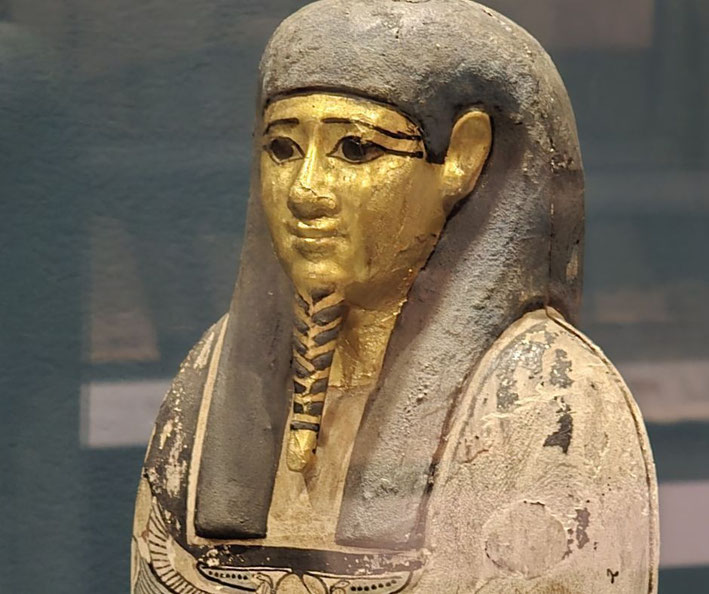An introduction to the world of Ancient Egypt

Ancient Egypt is one of the best-known of all early societies, because it seems particularly mysterious. Pyramids, tombs, mummies, and unusual deities have fascinated people for thousands of years.
The period known as ‘ancient Egypt’ lasted from around 3100 BC until 30 BC. During this 3000-year period, rulers known as ‘pharaohs’ governed Egypt.
When the last pharaoh Cleopatra VII died in 30 BC, Egypt fell under Roman rule, and the culture known as ancient Egypt came to an end.
Geography
Before the first pharaohs took control of Egypt, climate was essential to the society’s development.
Egypt is located in north-east Africa. Most of northern Africa is covered by the Sahara Desert, and people could not survive in deserts without access to fresh water.
So, rivers and lakes became central areas where communities and cities developed.
The largest river in all of Africa is the Nile, and this is where ancient Egypt originated.
The Nile became the primary geographical feature in all of ancient Egypt. All of the most famous Egyptian structures and sites are situated along this river.
Even though the deserts to the east and west of the Nile were regarded as highly perilous, they also provided security for the Egyptians: other nations did not want to march their armies across these deserts for fear of losing thousands of soldiers to dehydration.
The Nile
The Nile is the longest river in the world, measuring 6650 kilometres, over 4000 miles, from its source in Tanzania and Ethiopia to its mouth at the Mediterranean Sea.
Annual floods provided fresh water and delivered fertile soil to Egypt each year along the river.
In spring, heavy rains in Ethiopia produced floods that coursed through Egypt.
As the flood waters receded, rich, black, fertile soil was deposited along the banks of the Nile. This enabled Egyptians to cultivate abundant crops each year.
Due to the distinctive black colour of this soil, the people of ancient Egypt called the land along the river where they lived the ‘Black Land’ (in ancient Egyptian, kemet), and they called the red sands of the desert around them the ‘Red Land’ (in ancient Egyptian, deshret).

The Nile was also the primary transport corridor for the Egyptians. Travel by foot in the desert was slow and dangerous.
So, most people preferred to sail up and down the Nile on boats. It was faster, safer and more dependable.
Those sailing down the Nile, from south to north, could simply use the river current to move, while those sailing up the river, from north to south, had to harness the wind to move against the current.
The plants and trees in the delta region in the north that grew along the river also provided materials for constructing buildings, making clothing, and even creating paper from the papyrus plant.
Pharaohs and dynasties
The ancient Egyptian culture began around 3100 BC when the first pharaohs took control of Egypt.
The very first pharaoh was known as King Narmer, known in Greek as Menes. He was able to establish military control over most of the Nile in Egypt and set up his capital city in Memphis.

The role of the pharaoh began as a military warlord who had the authority to conquer the whole country and maintain command.
However, it also became a religious position, as it was believed that the pharaoh was a god.
As a result, the pharaoh usually passed his power onto his eldest son to keep it in the family.
As a result, one family could govern Egypt for centuries. A period of time when one family line was in power was called a ‘dynasty’.
However, there were times in Egyptian history when a pharaoh did not have a son to inherit the power, or he was overthrown by someone else who aspired to be pharaoh.
As a result, one family’s authority was replaced by another. A new dynasty began when a different family assumed power from the previous one.
Ancient Egyptian chronology
Such dynasties became a useful way of measuring time in ancient Egypt. In the 3rd century BC, pharaoh Ptolemy I asked a priest called Manetho to compose a book about Egyptian history.
Manetho therefore chose to organise his history around these dynasties.
Modern historians then developed a chronology of ancient Egyptian history based on his work.
They also divided Egypt’s 3000-year history into three major sections, called ‘kingdoms’, known as the Old, Middle, and New Kingdoms.
These kingdom periods indicated when Egypt was governed by pharaohs.
However, there were periods when pharaohs lost control, and the country descended into civil war.
These intervals of civil war were known as Intermediate Periods.
Based on the work of Manetho and modern historians, this is what Egyptian history looks like:
| Time Period | Approximate Dates |
| Early Dynastic Period | 3150–2686 BC |
| Old Kingdom | 2686–2181 BC |
| 1st Intermediate Period | 2181–2055 BC |
| Middle Kingdom | 2055–1650 BC |
| 2nd Intermediate Period | 1650–1550 BC |
| New Kingdom | 1550–1069 BC |
| 3rd Intermediate Period | 1069–664 BC |
| Late Period | 664–332 BC |
| Ptolemaic Period | 332-30 BC |
What do you need help with?
Download ready-to-use digital learning resources
Copyright © History Skills 2014-2025.
Contact via email
With the exception of links to external sites, some historical sources and extracts from specific publications, all content on this website is copyrighted by History Skills. This content may not be copied, republished or redistributed without written permission from the website creator. Please use the Contact page to obtain relevant permission.





